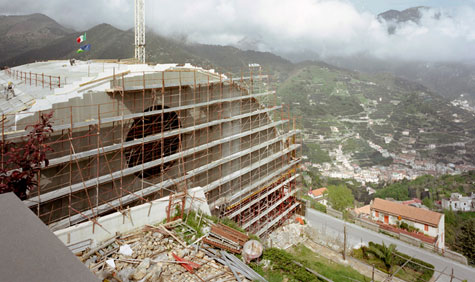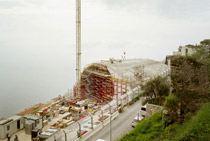Oscar Niemeyer auditorium, Ravello

Ravello, off South Italy’s coast, is one of the most beautiful and romantic spots on earth; and Brazilian architect Oscar Niemeyer’s all-white curvaceous auditorium is set amongst its luxuriant rocky hillsides and against the backdrop of the refined Amalfi coastal town’s trademark awe-inspiring brilliant blue sea and endless open skies.

See more images of Niemeyer's striking auditorium under construction in Ravello
Though officials were still half-heartedly touting the official June 30th inauguration date when we spoke to them in late April, completion is due in September, ready to showcase the new auditorium’s unique feature: its over-hanging canopied roof (or solaio a sbalzo in Italian). More plainly put, this means that while the amenities are set off the entrance piazza or in the floors below, a section of the 1,500m2 canopy, which contains the actual auditorium space, literally and strikingly, hangs in the air supported by nothing.
Another distinctive feature of the curving venue is the eye-shaped window, a recognizable Niemeyer-esque theme built into its southeastern facade next to the stage. Through this opening, the audience can contemplate the sea, while at the same time listen to the music or watch the performance taking place on stage. Niemeyer was adamant that the audience should have an unencumbered view of the shimmering water as they listened. The stage can be manipulated to three different levels and is “designed to blend and become one with the foyer” says Architect Rosa Zeccato, who is Technical Director at Ravello City Council.
Niemeyer is best known for doing up the brand new Brazilian capital of Brasilia in modernistic and exalted curves of reinforced concrete and symmetrical perspectives, in the late 1950s, but also for his remarkable zest for life. He is due to turn 102 this December and famously remarried (his 60-year-old secretary) aged 99 following the death of his first wife.
Niemeyer himself has actually never been to Ravello, though his right-hand man – an engineer called Susskind - has on many occasions. The architect designed the auditorium for his good friend and chairman of the famed Ravello music festival, Domenico De Masi. Niemeyer’s sketches for the auditorium, which can be seen on the Ravello festival website, are of an immense graphic beauty, imbued with sensitivity, a lightness of touch and a strong poetic force that harks back to some of the sketches by Le Corbusier (with whom Niemeyer worked with in the 30s).
The site of the 400-seat auditorium is a short walk from Ravello’s main piazza and about 200m from Villa Rufolo, whose glorious gardens have until now been the prestigious three-month long well-known local music festival’s main venue. The covered auditorium will give the festival, and other local cultural events, a new lease of life and hopefully turn Ravello into a year-round destination, as Zeccato explains.
Wallpaper* Newsletter
Receive our daily digest of inspiration, escapism and design stories from around the world direct to your inbox.
One thing immediately noticeable however, is that the site is also quite small given that the auditorium will include a bookshop, a bar, rehearsal areas and an underground parking for 80 cars. A surrounding winding road on both sides makes the site accessible for visitors, but also potentially increases dangerously the traffic in what has been until now, a quiet and idyllic city, thus leaving the sense that a little more space would certainly have been welcome. As land- and property-owners were in fact expropriated from the spot to build the venue, there is unconfirmed talk of some refusing to cede their land, resulting in compromise regarding the site’s size. And this is not the only problem the build has encountered. From the 26,000 square metres of rock that had to be excavated and the massive steel poles that had to be fitted to secure the land and avoid landslides, to the various lawsuits and appeals filed by environmental and heritage associations, the forceful opposition from local residents and the in-fighting by political factions, the auditorium seemed at one point to be languishing in a sea of bureaucracy, political opportunism and technical obstacles.
However, now that the building is taking shape, almost completed, even though some of the controversy may remain, the excitement is certainly starting to take over. As Zeccato says, the auditorium is a “work of art” and as such it can only enrich the area’s cultural heritage.
Giovanna Dunmall is a freelance journalist based in London and West Wales who writes about architecture, culture, travel and design for international publications including The National, Wallpaper*, Azure, Detail, Damn, Conde Nast Traveller, AD India, Interior Design, Design Anthology and others. She also does editing, translation and copy writing work for architecture practices, design brands and cultural organisations.
-
 From Rembrandt to Warhol, a Paris exhibition asks: what do artists wear?
From Rembrandt to Warhol, a Paris exhibition asks: what do artists wear?‘The Art of Dressing – Dressing like an Artist’ at Musée du Louvre-Lens inspects the sartorial choices of artists
By Upasana Das
-
 Meet Lisbeth Sachs, the lesser known Swiss modernist architect
Meet Lisbeth Sachs, the lesser known Swiss modernist architectPioneering Lisbeth Sachs is the Swiss architect behind the inspiration for creative collective Annexe’s reimagining of the Swiss pavilion for the Venice Architecture Biennale 2025
By Adam Štěch
-
 A stripped-back elegance defines these timeless watch designs
A stripped-back elegance defines these timeless watch designsWatches from Cartier, Van Cleef & Arpels, Rolex and more speak to universal design codes
By Hannah Silver